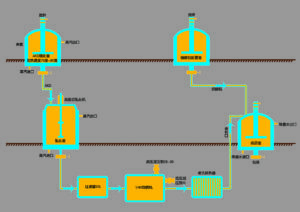Why is it necessary to process AKD wax powder into AKD emulsion?
AKD (Alkyl Ketene Dimer) is an important paper sizing agent, and its core function is to give paper water resistance. AKD originally existed in the form of wax powder, which is a white or light yellow solid at room temperature. It has the characteristics of strong hydrophobicity and high melting point (about 50-60°C). However, the direct use of AKD wax powder has problems such as poor dispersibility and low sizing efficiency. Therefore, it needs to be converted into a stable AKD emulsion through an emulsification process to meet the needs of the modern papermaking industry.
How is AKD wax powder processed into emulsion?
Required Equipment and its function:
- Reactor – stainless steel reactor equipped with jacket heating system, melts solid AKD wax powder into liquid.
- Emulsifying kettle – emulsifier with high-speed shear (1000-3000 rpm) to achieve preliminary mixing of AKD melt and emulsifier.
- High-pressure homogenizer – force the emulsion to pass through micron-level gaps through 20-50 MPa high pressure to break the particles to 0.1-1μm.
- Filter tank(20L) – remove unemulsified wax blocks and mechanical impurities.
- Plate heat exchanger – use a stainless steel plate heat exchanger to cool the emulsion from 60℃ to below 30℃.
- Aluminum sulfate preparation kettle – prepare cationic emulsifier solution (such as aluminum sulfate or cationic starch) to enhance the charge stability of the emulsion.
- Finished product kettle – configure AKD emulsion of required concentration
Processing flow:
Step1: Put the solid AKD wax powder into the reactor and heat it to 65-75℃ to melt it into liquid state, while stirring at a low speed to ensure uniform heating.
Step2: The molten AKD and the emulsifier solution – chromium oxychloride are added into the emulsification kettle and mixed under high shearing speed (1000-3000 rpm) to form a coarse emulsion (particles 10-50 μm).
Step3: The crude emulsion is processed 2-3 times by a high-pressure homogenizer at a pressure of 20-50 MPa to refine the particles to 0.1-1 μm and improve the uniformity.
Step4: The emulsion is cooled from 60°C to below 30°C within 5-10 seconds by a plate heat exchanger to prevent AKD from hydrolysis.
Step5: Dissolve a cationic emulsifier (such as aluminum sulfate or cationic starch) in an aluminum sulfate preparation kettle to prepare an emulsifier solution at 50-60°C.
Step6: The filtered AKD emulsion is transported to the finished product kettle and mixed with the prepared aluminum sulfate, the pH is adjusted to 6.5-7.5, and stored in a closed state under nitrogen protection to ensure stability.
AKD emulsion processing flow diagram
What we supply?
We can supply AKD wax powder, full set of equipment, emusion processing technology, and all auxiliary materials (aluminum sulfate, magnesium sulfate, urea, etc.)
Should you have any interest in making your own AKD emulsion, please feel free to contact us at chris@huataogroup.com or sending whatsapp message to +8619322109200.

